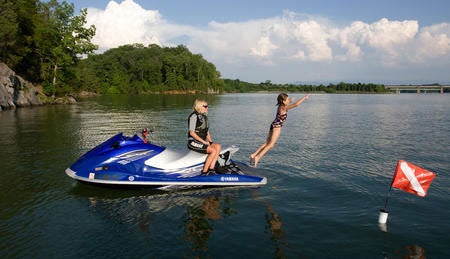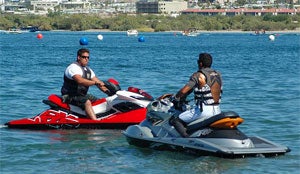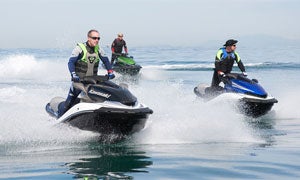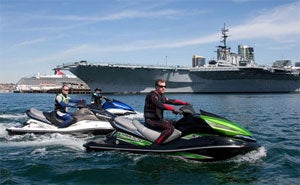PWC Rules of the Road
Avoid dangerous situations by following these time-honored navigation rules
With the first weekend in July now in the history books, the summer PWC riding season is officially underway, and with it an abundance of people looking to enjoy the outdoors. To most of us that means long sunny days, attractive (and not so attractive!) bodies in skimpy swimwear, and plenty of time to enjoy riding your personal watercraft.
What summer also means, however, is that right now your local waterway will likely be more crowded than ever, playing host to everyone from the experienced yachtsman to that eager, first time fellow PWC enthusiast. Unfortunately, that means the risk for a potential accident is at an all time high.
Many of the collisions and accidents that occur on the water are the result of boaters not being familiar with, or for that matter, understanding the basic rules of the road. Just like when you are operating your car, there are rules to be followed. Problem is, to drive a car you need to pass a test. To operate a PWC after a certain age, in most places it’s just hit the throttle and go.
 Summer is in full swing so it’s time to talk about PWC safety.
Summer is in full swing so it’s time to talk about PWC safety.Need a refresher course on the nautical rules of the road? Take this quick quiz:

When meeting another boat head-on close enough to risk collision, should you…
a. Maintain your present course, allowing the approaching craft to avoid you.
b. Keep the approaching vehicle to your port, or left side, while the approaching driver does likewise.
c. Yield to whichever craft is traveling at the faster rate of speed.
d. Floor it and hope for the best.
Hopefully you guessed that the answer was B, with each operator keeping the approaching vessel on his or her port side. Another way to think of this rule is when approaching another craft head on, each boat should simply keep to their right.
When approaching another craft from behind, should you…
a. Allow the craft in front to maintain its course and speed, staying out of that craft’s way until you are safely past.
b. Pick whichever side looks safer and quickly move past.
c. Wait until open water and head another direction.
d. Make like a car, and always pass on the boat’s left (port) side.
The answer here is A, to allow the craft in front to maintain its course and speed, moving carefully past on whichever side is safest. If it’s a narrow channel, passing on the right is considered proper.

You’re approaching another boat or PWC in open water at a right angle, and both of you are on a collision course. Do you…
a. Speed up to cross in front of the other craft.
b. Allow the boat on the left the right of way.
c. Allow the boat on the right the right of way.
d. Wave your arms and curse loudly.
This is kind of a tricky one. The correct rule is C, the vessel on the right-hand side is considered the “stand-on vessel,” and thus gets the right of way. The “give-way” vessel must slow, stop, or even reverse if necessary to allow the stand-on boat to safely pass.
But wait, you’re the craft on the right, but the boat on the left’s a sailboat. Rules still apply?
a. Of course, make ‘em slow down so you don’t have to alter course.
b. Blow your whistle and accelerate to pass in front of the sailboat.
c. Hope the wind dies.
d. Back it down, and pass behind the sailboat.
The answer is D. In general, sailboats, fishing vessels, and boats powered by oars or paddles always have the right of way. Give them a wide berth, changing your course to avoid them whenever possible.

You and another PWC pilot encounter each other out on the water. You are unclear as to who has the right of way, and your speed and proximity make a collision a real possibility. You should…
a. Maintain your present course.
b. Both immediately slow and yield the right of way.
c. Give the larger boat the right of way.
d. Wish you had read that part about “off-throttle steering” in the owner’s manual.
This one should be obvious. The answer is B. Remember, the rules can’t take into account every conceivable situation. On a watercraft, it’s always a good idea to stay at least 200 feet away from any other boats out on the water. Momentum, waves, current, etc have carried many an unsuspecting pilot into a collision.
That’s why the rule above all other rules is always be prepared to take evasive action… even if you are clearly in the right of way.
Other good guidelines to keep in mind this summer?
Avoid wake jumping. The laws vary from state to state, but in general jumping the wake behind a motorboat is illegal within a specific distance.
Look over your shoulder before you make a turn to determine if any traffic is either alongside or overtaking your craft from behind. The noise of your engine typically drowns out the noise of a passing boat. Look before making a move.
Don’t splash or roost a fellow rider. Sure it seems to happen all the time, but there have also been serious accidents resulting from someone misjudging the turning ability of their craft, or encountering an unexpected wave.
Remember that even things like brakes or off-throttle steering advancements are still no replacement for a good, savvy, alert operator. Pay attention…always.
Related Reading
Five Tips for a Worry-Free Summer
Teaching Kids to Ski Behind a PWC
The No-Stress Way to Launch A PWC at the Ramp
Safety Alert System for Personal Watercraft
Get PersonalWatercraft.com in your Inbox!
Like PersonalWatercraft.com on Facebook
Comments
Most Popular

2025 Yamaha JetBlaster PRO 2-Up Review

2024 Kawasaki Jet Ski STX 160X Review

Remembering the Sea-Doo XP

Whatever Happened to the Wetbike?

2025 Yamaha JetBlaster Review












 Your Privacy Choices
Your Privacy Choices